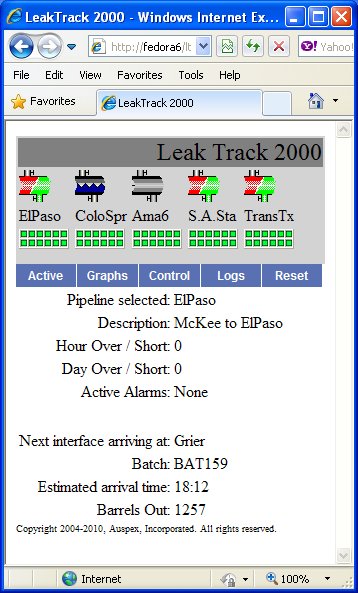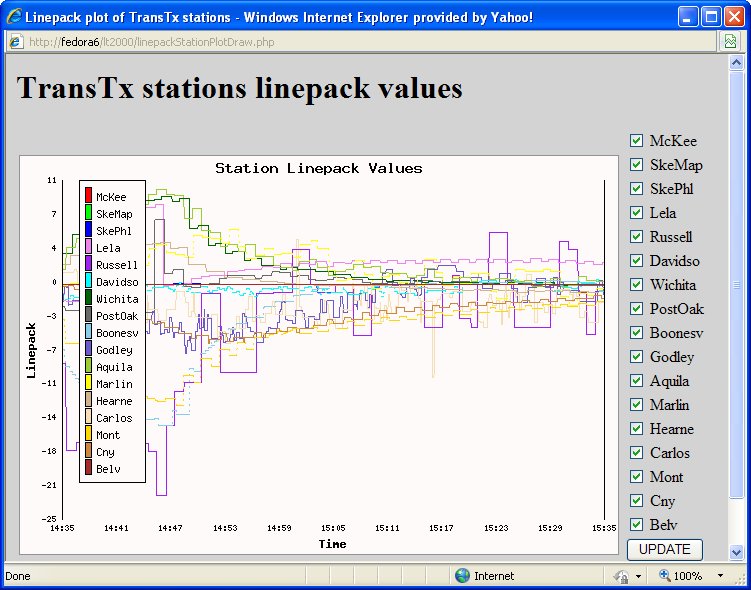Leak Track 2000

Leak Detection made easy
Why leak detection?
A pipeline leak detection system monitors your pipeline 24x7. There are no bathroom breaks, no distracting phone calls/events, and no operator fatigue oversights. The faster the control center detects a leak, the less the overall costs will be. Early detection means faster response to the leak, better site containment, improved public relations, and less clean-up expenses. Pipeline leak detection software can be a very cost effective application to your arsenal of pipeline management tools. Knowing when and where a leak happens allows you to take better control of the situation, minimizing cost and potentially bad press.
Basic types of software based leak detection.
Computational Pipeline Monitoring or CPM for short, is a way of taking the various
pipeline instrumentation data points to determine if product is being lost or stolen.
Some leak detection software requires extensive, high speed, and
highly calibrated data points work properly
while others advertise they only need a few pressure points.
The basic CPM methods are:
- Modeling, requires special training to setup and maintain plus extensive and highly calibrated field instrumentation. Initial setup will require detailed pipeline physical and topographical information. The user is required to periodically recalibrate the model as the pipeline ages or changes. The model predicts the expected state of the pipeline based on earlier data and alarms when the data doesn't match.
- Statistical, can take a significant time to "learn" how a pipeline operates. If a pipeline is changed, the software will have to relearn what is normal operation. Once a large enough statistical sample has been collected, the software compares the current operation to previous samples and alarms if the data starts to deviate.
- Deviation, includes mass balance/line pack, flow deviation, pressure wave analysis and other monitored data. Once a deviation is detected, for example a pressure drop, the software attempts to determine what might have caused the deviation. Additional external factors are taken into account, such as pump / valve status, to determine if this is a valid leak or a normal upset condition. Because of the way it operates, slower telemetry or less than perfect data have little impact on the performance. For older pipelines, especially those with legacy communication and instrumentation, this is a good choice verses other methods.
All three CPM methods look for a deviation in the pipeline operating parameters. The primary difference is how they evaluate the data to determine a leak.
About Leak Track 2000
Leak Track 2000 (LT2000) is an economical, simple, reliable and accurate pipeline leak detection system for pipelines. LT2000 uses multiple API 1130 methods, integrated together, to form a simple but robust leak detection system. Unlike some simpler leak detection technologies, LT2000 excels at handling transient conditions. LT2000 is easily be integrated in to existing telemetry and SCADA system. Leak Track 2000 does not require a special staff to operate or maintain. LT2000's intuitive interface means operators can start using the system immediately without extensive training. LT2000 is an excellent choice for for a leak detection application for a company wanting leak detection but does not want to invest heavily in software, training, and maintenance.
User Interface
LT2000 comes with an easy to use HTML interface.
All web pages are automatically generated eliminating the need for
special skills for maintenance.
The web based interface allows users access to leak detection and production data
from any authorized workstation.
Users have access to pipeline data in an easy to understand form along
with pipeline integrity and leak information.
Important events such as a batch interface or scrapper (pig) arrival times are displayed.
In addition to normal pipeline data, historical information
(alarms, events, leaks, operator actions) is recorded.
Leak Track Features
Leak Track 2000 consists of a fast and reliable leak detection method along with many standard features to help operate your pipeline.
- Leak alarm analyzer - analyzes the entire state of the pipeline, generally eliminating false alarms.
- Rapid leak detection and location - leaks are rapidly detected and determined.
- Transient processing - non-stop processing even during pipeline upsets.
- Batch and pig tracking - track location and arrival time for batches and pig/scrappers.
- Batch scheduling - queue for pending batches.
- Real-time training simulator - mix real-time data with training simulation data.
SCADA Interface
LT2000 uses a simple, easy to understand, non-proprietary data interface
allowing SCADA systems to quickly interface with Leak Track 2000.
The data can be generated directly by the SCADA software or with an alternative application.
All data is available for import back into your SCADA system.
LT2000 operator functions (displays, entering data, etc.) can also be directly managed by the SCADA
system allowing for a fully integrated leak detection system.
Stand-alone Operation
Using the PLC interface, LT2000 can be used as a stand-alone pipeline leak detection system. As a stand-alone system, it does not require a SCADA platform yet still provides all Leak Track 2000 features. This includes fast and accurate leak detection, leak location, batch and pig tracking, batch scheduling and the real-time training simulator. The PLC interface with high speed telemetry can support highly accurate leak locations. In some cases, a leak can be localized to within about + or - 100 meters.


